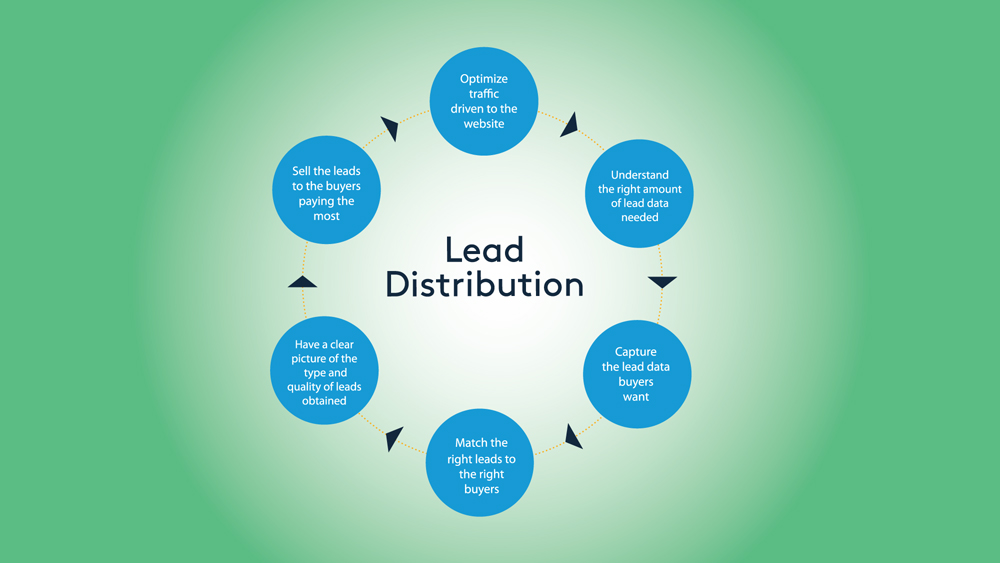Lead Distribution: What Is It, The Value and Tools for Selling Leads

Selling leads through a lead distribution program can be profitable for businesses across multiple vertical industries. The key is knowing what to do with your qualified lead data to get the most value out of your campaign traffic.
So, how exactly does lead distribution work? A lot goes into building a lead distribution program. The following will take you through the fundamentals of lead distribution, including its definition, the process of selling leads, and technology requirements.
First things first: What is lead distribution?
Lead distribution is a marketing technique that links businesses with the right customers for their products or services. The process of selling leads involves capturing, validating, and distributing leads in real-time. For lead sellers, the objective is to generate high-quality leads that can be sold for a premium.
The value: Benefits of lead distribution
The value of lead distribution lies in the ability to monetize leads – or maximize the value received for leads sold by getting the best possible sales price – beyond what’s possible with click traffic. With a traditional CPA program, every conversion is worth the same amount regardless of a person’s details and conversion activity. With lead distribution, the appropriate price for quality leads varies upon criteria.
Additionally, lead distribution provides the opportunity to nurture connections with affiliates and advertisers (or lead purchasers) as they play a more significant role in capturing higher-quality leads.
The vernacular: Lead distribution glossary
- Closed-loop measurement: An end-to-end view into the lead acquisition funnel, from the traffic source campaign details to buyers’ lead statuses and quality reports.
- Lead: A pre-determined set of consumer information or qualifications that can be useful in selling products or services to a consumer.
- Lead buyer: A business that purchases leads generated by websites.
- Lead capturing: The process of collecting consumer information from website visitors.
- Lead enrichment: Additional information about a lead (i.e. credit score, driver’s license) which can be acquired through a third-party enrichment tool or a lead-enrichment process such as a call center.
- Lead distribution: The system of distributing leads to buyers based on pre-determined criteria.
- Lead monetization: The approach of maximizing the value received for leads sold by getting the best possible sales price.
- Ping post: The ping post functionality is set up to give buyers a preview of the lead details from a form submission (i.e. lead’s zip code, salary range, case notes, etc.) without providing contact information. This allows buyers to indicate the amount they’re willing to pay for each lead depending on its content and quality. If you decide to sell it to the buyer for their proposed amount, you can then post the full lead to the buyer.
- Ping tree: A ping tree is a client’s list of eligible buyers on each lead sale attempt. A ping tree allows lead sellers to set up a workflow based on buyer rank, round-robin functionality, weighted prices, pre-defined buyer volumes, and more.
How lead distribution works with selling leads
The bottom line for any lead generation business is getting the most out of every lead you sell. This can be done once leads are brought into a lead distribution system and are sent on a path that is most likely to lead to conversion.
Here’s how you start. When a person fills out their information through a web form – whether it is for standard contact information or comprehensive information such as business interest – you can use this data to begin the process of selling leads. To sell leads to companies, you’ll need to examine all available consumer data as well as the information about the lead buyers, who have changing and differing needs. The right data and a complete view into the type and quality of leads you receive will allow you to sell leads to the right people – who pay the most.
The following shows how the lead distribution cycle works:
The tools: How to choose a lead distribution technology
Lead distribution technology is a must-have if you want to streamline the lead distribution process and save valuable time and money. With the right software provider, you’ll be able to achieve your program’s most important objectives and then some.
The following steps will help ensure that you select the lead distribution software that matches your needs and maximizes the profitability of every lead.
- Step one – objectives and goals: Determine what you’re really looking to do with your lead distribution software. Do you want more control over lead quality? A closer look at buyer requirements? Protection against fraud? You will likely end up with several goals, so jot them down and prioritize them.
- Step two – checklist: Consider how your goals align with the specific features of the software you’re considering. Examining capabilities related to the fundamentals of your lead distribution program – such as reporting, lead validation, lead distribution, etc., – will help you weigh the importance of certain features.
- Step three – compare options: After your goals and feature requirements are mapped out, compare at least two to three technology providers. A side-by-side comparison will provide more context into the specifics of what you want and need from your lead distribution software provider.
For examples of specific goals, features, and capabilities to consider when choosing the right lead distribution technology provider, use this checklist.
Learn More
For more best practices about selling leads, you can also check out these resources:
- Blog: How to Sell Leads to Maximize Profit: Everything You Need to Know
- Blog: How to Run a Successful Lead Generation Program on CAKE
- Whitepaper: Better Together: Adding Value to Your Affiliate Program with Lead Distribution
